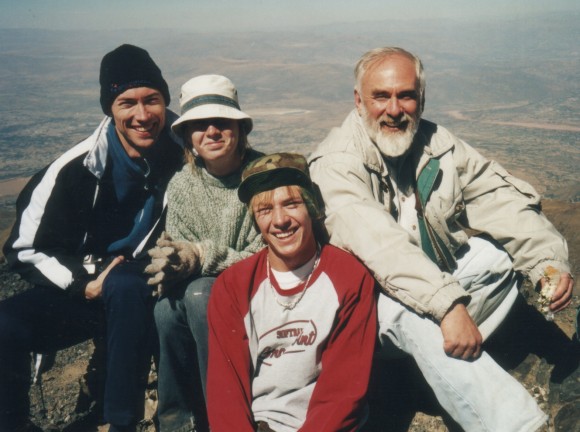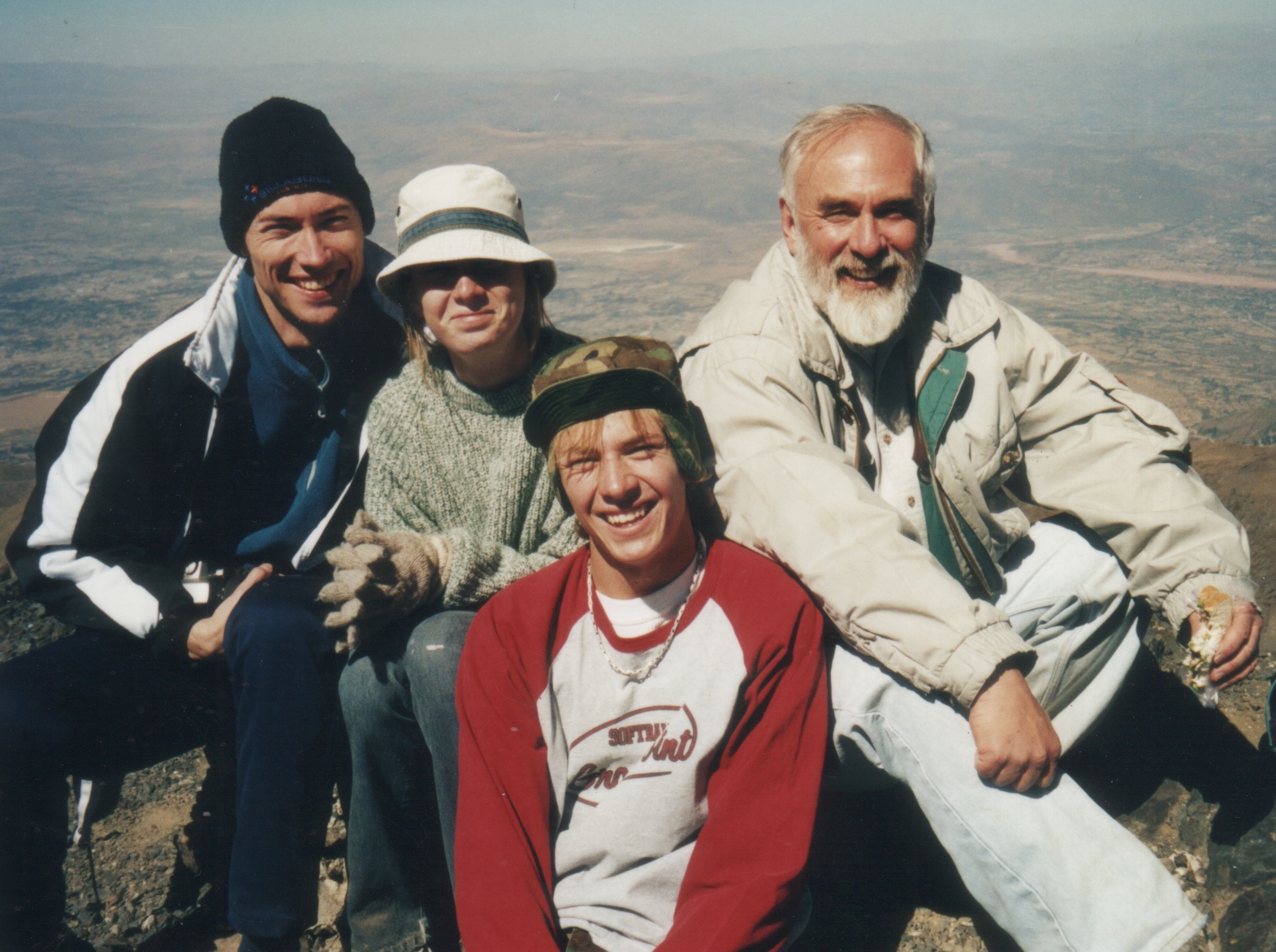We continue Dad’s account of his perilous ascent up Mt Tunari. Here’s Part 1 if you missed it. Anyways, we’re half-way up…

No sooner had I arrived than, of course, the others headed off, making a huge effort to appear to be enjoying the agony that no doubt they were all experiencing. I could but wonder at their wasted efforts in this pretense. Jim and John had stopped behind on the ledge while Jim explained to John how the glaciers, with crevasses big enough for a full sized bus to get lost in, had been formed on the mountains far below and how he had climbed many mountains much higher than this. That, I did not need to hear, so I busied myself by taking my hefty thermos from the side of my backpack with the idea of trying to slurp some hot chocolate from it in between gasping for air and watching it be whipped away by the blizzard that was blowing. “Hot chocolate!†shouted Jim and John in unison. “Here,†said Jim, “Let me give you a hand up.†“OK,†I said, “I’ll give you a cup each here and another when we get to the top.†They gulped down the chocolate and feeling somewhat revived, we set out for the summit. It wasn’t long before the snow we were going through was almost thigh deep and I noticed that Jim and John were really struggling. The advantage offered by the snow was that you did not bruise your face badly every time you fell over. The major disadvantage was that you could not always tell just where the precipice edges were – although by this time the sight of a shear drop of 10,000 metres just 5 centimetres from your feet caused little concern. As we finally neared the summit I was surprised at just how much puffing and gasping was coming from Jim and John. “Actually,†I said to them, “I thought this part would be much harder.â€
Jim said something quite loud in Aymara and they both dropped me unceremoniously in the snow. It didn’t really matter as we were almost at the top with only a curved ridge around the nub of rock at the top to be negotiated. Fortunately there was no snow at this level as it had all been blown away by winds that seemed to have a velocity of somewhere approaching the speed of sound. Certainly it made talking almost impossible. Even if you could have been heard, the shapes the howling gale made of your face and open mouth would have made the formation of words quite impossible. The ledge that presented the final barrier to the summit was around 2 centimetres wide with a sheer drop on the right of an unimaginable distance. On the left, the rock wall showed all the signs of previous expeditions—pieces of fingernail, frozen streams of blood from numerous grip-seeking fingers, and even some indentations where the fingers of stronger climbers had managed to penetrate the rock. One did not even want to think about what coming back down this way would be like. Still the summit was reached at last and all you could hear was the screaming rush of air. I suggested to the guys that they stop breathing for a second so we could hear the wind at the summit but they took no notice. We nudged the frozen forms huddled at the top to let them know we had arrived too. The huddle slowly gave way to body shapes, one of which asked why we had taken so long. I don’t know why but Jim and John glared at me—and for some reason some unveiled threats were made against my person though these stopped as I once again took out my thermos flask. We bent into the wind, our eyes watering too much to be able to see any view. Aemon said he was hungry and took a sandwich out of his bag but his frozen fingers didn’t have a good grip on it and the wind whisked it away. I estimated that at the speed it was going it would probably have been at the other end of the Cochabamba valley, over Lake Angostura, in under 5 minutes. The time spent at the summit was kept to a minimum on account of the wind and cold. While I’m sure the temperature could not have been as low as the minus 200 degrees claimed by several in the party, the wind chill factor would have brought it close. The descent around the ledge and through the snow is a blur in my memory—no doubt my brain has deliberately blanked it out so that I would not suffer permanent psychological damage. There was an obvious, and very quick way to get down from the top and we debated this for some time before eventually deciding to climb down instead. In the end it was probably for the best—for our families and the mission’s insurance company. As we descended we felt that wonderful warm rush of blood through our bodies as we descended out of the snow and into temperatures only slightly below zero. It was therefore with elated hearts that we arrived at the top of the scree slope again, although the elation was probably due to some narcotic effect on our brains produced by hypothermia and prolonged oxygen starvation. As we were all contemplating the best way to make our way down the slippery slope, Jim, out of his vast experience, told us that we could make it down by taking what he called “giant†steps. This seemed to make little sense and some members of the party set off by sliding down on their feet—backsides—backs, leaving wisps of shredded cloth and flesh in their wake. I could not detect an evil grin on Jim’s face and so, having reached the place where common sense isn’t too common any more, I decided to try his suggestion. Taking giant steps worked really well. This surprised me as I hadn’t been impressed with Jim’s qualifications as a mountaineer to this point. The idea was that you would take a large step out into thin (very thin) air and you fall until your foot hit the shale somewhere way below. Each step of a metre horizontally would take you down about 10 metres and the shale was broken up so that you would sink down into it enough to break you fall before taking the next step with your other foot. The speed with which one could descend using this method was impressive indeed and on reaching the bottom, around 2 kilometres below, you had to look back up the slope and remember the agony of the hours it had taken you to climb it. Of course, from this point on your speed was very much reduced as walking had now become an extremely difficult and painful process. This was due to an unmentioned flaw in the giant step procedure. While in theory this was an excellent and exhilarating decent method, in practice one found that not enough consideration had been given to the fact that the mountain is made of solid rock and that the scree may not always be many feet thick. The realisation of this came as on about the 20th giant step, my right foot descended onto the scree to find that it was only about a millimetre think and as the rock under the flimsy surface seemed to resist all attempts of my Adidas sneakers to penetrate it, my right leg immediately sought refuge in the right side of my body—my knee taking up permanent residence around the region of my hip. Despite the pain induced, it was probably fortunate for me that the procedure was repeated on the next step with my left leg. When we got back to the cars sometime the next day, I mentioned to some other members of the team that though walking in this condition was obviously painful in the extreme, at least I was balanced. They looked at me for a second and said that they couldn’t agree, but I don’t know what they meant. The drive back down to Cochabamba was quite uneventful—if you don’t take into account the constant worry of fading brakes on the incredibly steep, wickedly winding and badly constructed “road†with seemingly bottomless drop-aways and no guard rails. There was also a stop that had to be made for one of our Aussie friends who decided to leave her lunch beside the road, apparently in consideration of the local fauna. And of course trying to drive while in a state of utter exhaustion, snow blindness and severe sun and wind burn is a challenge few have experienced.
Finally we arrived home to a ticker-tape—or toilet paper—welcome and being greeted by our families, waving flags. We the heroes, the conquerors of the mountain, had made it.
